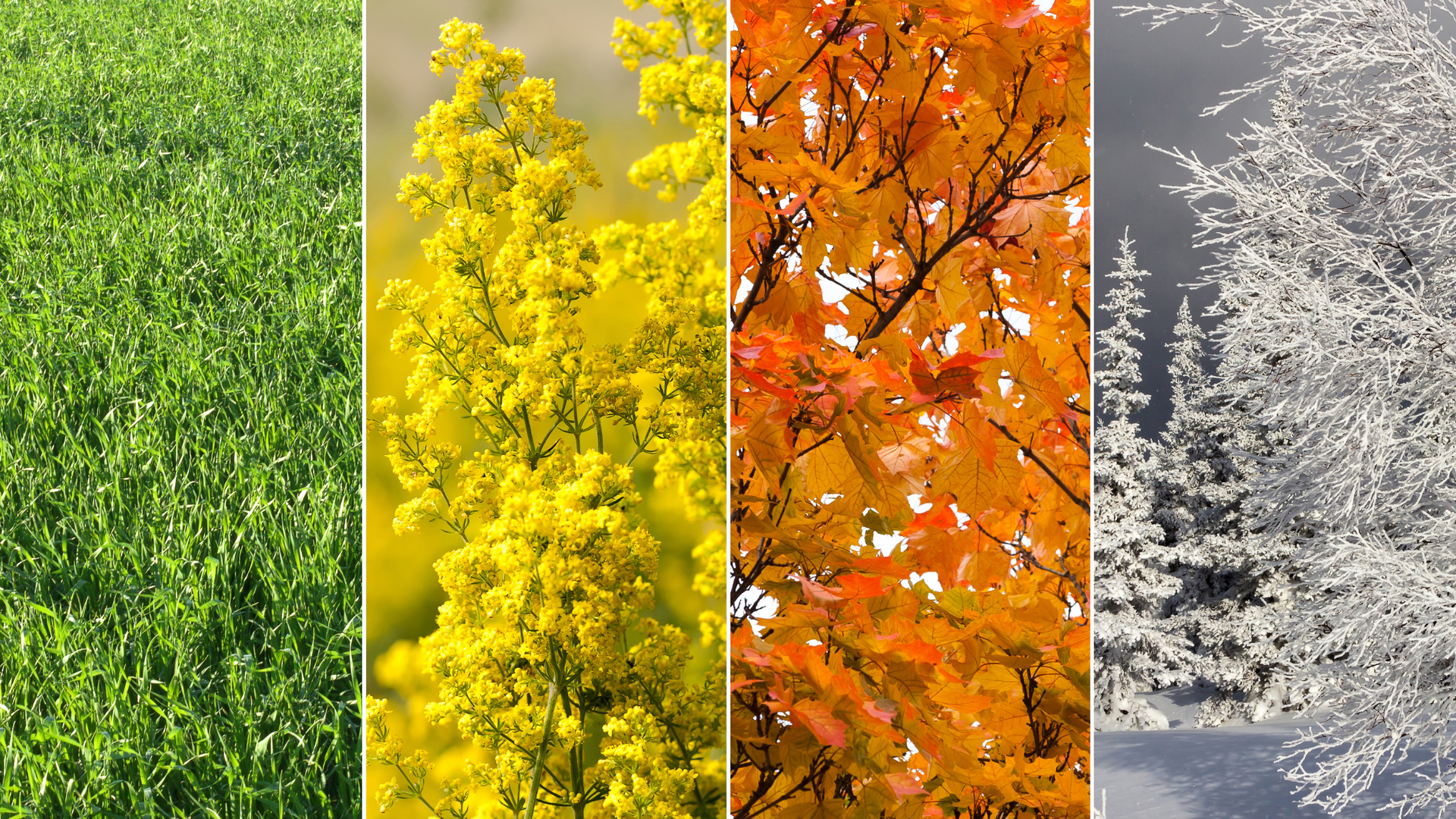One thing that the drudging-on of the pandemic taught me was an appreciation for the changing of the seasons. In the early full-lockdown days I was able to enjoy the full spectrum of Spring erupt outside my guest-bedroom-turned-counseling-office window. I could take breaks to walk around outside between client sessions, and I finally took on some of our household plant caretaking duties that usually belonged fully to my husband and his genetically-acquired green thumb.
It occurred to me that seeing the daily progression of my surroundings change was an unintended quick course on the importance of practicing presence and patience.
This experience, combined with the entrance into my 30’s and the compulsory nostalgia that accompanies such an event, created an awareness in me of how important the changes in our natural world are for my overall wellness.
In reflecting on this phenomenon lately, the best word I could conjure for it is cathartic.
My ever-faithful friend Google Dictionary shared with me that cathartic means that something provides psychological relief.
And dear goodness, if you have ever experienced a Texas summer then you can agree wholeheartedly that Autumn brings relief from every side.
The whole state finally takes a true, deep breath sometime in mid-October that we have been holding in since May.
But what it is it that gives us such a relief each time the seasons change? I have been thinking about this a lot, and I think it comes down to four main concepts.
1. Changing of the seasons provides rhythm to life.
Rhythms of life provide structure, context, and comfortable predictability. When it comes to the changing of the seasons, the Lord could have easily left us in a bland and unchanging state of being, with little variation in our environment. But I believe He provided gentle (and sometimes not so gentle) changes to the natural world throughout the year to remind us of His consistency, promises to provide, and ultimate power.
Though we are no longer as connected to our food sources as previous generations once were, it is important to consider how the predictable times for planting, harvesting, storing, and feasting continue to play a large role in the human experience.
Many of our cultural traditions still follow this pattern. Regardless of your role or occupation, there are times of new projects and hard work, times of growth, times to celebrate, and times of reflection—all which seem to point to similar seasonal themes of our agricultural ancestors.
2. The changing of the seasons offers much-needed connection to the physical world.
My lockdown-era experience highlighted this in a stark way.
If we regularly roam about from indoor activity to another, we miss out on the emotional and biological regulatory benefits of witnessing the changing of the seasons
(To learn more about these benefits, visit our previous blog on Wilderness Therapy here).
In the therapy world, we often preach to clients the importance of practicing presence to offset a host of mental disorder symptoms and general stress.
Practicing presence is done by activating all 5 senses, which is honestly easiest to do when one is outdoors where the senses can be best utilized. The idea is that if a person is actively focused on what he or she can smell, taste, see, feel, and hear in their present environment, then it is much more difficult to dwell on anxieties outside of that present environment. The more one practices presence, the easier it becomes to ward off unnecessary stress.
Finding moments of such presence in the modern world is a difficult feat. Being alone with our thoughts can terrify us, so we reach for our screens or for any distractions to remove us from the present moment.
The changing of the seasons challenges the rat race mentality and calls us to slow down, to breathe, and to participate in a natural display of balance and beauty.
3. Our brains and bodies are wired to respond to the changing of the seasons.
I will be honest, this is a scientific rabbit hole that I spent way too much time delving into today. To sum up my findings, it seems that researchers agree that our bodies and brains naturally respond to our seasonal environments in a variety of ways, but there remains much to be discovered about how each body system is impacted.
Several studies have concluded that different parts of our brains seasonally grow and shrink to meet necessary demands, though scientists are still unsure as to why each of these brain functions shift exactly when they do [1, 3]
There has also been new evidence to suggest trends of seasonal variation of symptoms for people with multiple sclerosis, chronic headaches, depression, dementia, psychosis, and schizophrenia [1, 3, 4, 6, 11]. The findings about these seasonal trends can help those who suffer with symptoms of these different diagnoses make a personal wellness plan and be prepared to garner extra resources and support during more difficult months of the year.
And of course, there is the well-known example of Seasonal Affective Disorder, a kind of depression that emerges each year in the fall and persists through the winter months [7].
Seasonal changes also appear to biologically impact generally healthy individuals. It is normal for metabolism to change during the winter months due to natural insulin resistance [5, 10], and for barometric pressure to increase the prevalence of headaches, especially for women, during autumn [1].
So what do we do with all of this seemingly unrelated information? Why does it even matter? For myself, I think it tends to point toward the idea that we were meant to be an active presence in our natural environment, instead of completely closed off in comfortably regulated buildings for the majority of our lives. While we may not know all the “ins and outs” of the environmental connections to our bodies and brains that the seasons bring, these scientific conclusions remind us the importance of being present where we are, and listening to our body’s rhythmic cues to better take care of ourselves and others.
Proponents of “seasonal living” such as Dr. Myle Spar [10], suggest that anyone can practice elements of living in conjunction with the seasonal shifts. Some components of this lifestyle may include intentionally eating foods that are seasonal in your area, shifting exercise regimens to include outdoor activities when the weather is pleasant, and practicing mindfulness during times that SAD or other concerns are more likely to impact you [8, 10]. It honestly appears to be a quite simple practice that promotes small changes in your lifestyle that shift with the seasons to achieve overall balance.
4. Last, but certainly not least, the seasons activate nostalgia.
I am certain all of us could provide our own vivid example of nostalgia, otherwise defined as a “sentimentality for the past” [2]. We have all caught a familiar smell or seen an old photo that sends us hurtling into another time and place altogether. Sometimes these little moments surprise us, and the nostalgia can feel all-consuming.
The changing of the seasons does exactly this on a large scale, using all our senses. It is ironic, actually, that the same 5 senses that help us practice presence are also the very things that summon nostalgia, with its countless memories and resulting emotions in tow.
For the most part, nostalgia is a harmless part of the human experience that brings comfort and sweet, affectionate yearning for times long gone. And usually, “the hauntings of times gone by, and the imaginings of times to come, strengthen us in lesser times” [2].
We welcome each new season because it is both new and familiar at the same time: a fresh opportunity for growth within the safe and cozy space of an old friendship.
In a way, the changing of the seasons are simply tangible mile markers to the passage of time; they mark our personal connection to the tiny blip of human history in which we participate. And each time that mile marker reappears, it drags with it the memories of highs and lows of the times we have been here before.
The changing of the seasons: They are happening constantly, and yet we rarely stop to notice. What lessons could we learn from these little, daily shifts in our world that lead to grand transformations?
Sounds like a fantastic counseling metaphor if you ask me.
References:
1. Book, G. A., Meda, S. A., Janssen, R., Dager, A. D., Poppe, A., Stevens, M. C., Assaf, M., Glahn, D., & Pearlson, G. D. (2021, March 24). Effects of weather and season on human brain volume. PLOS ONE. Retrieved October 7, 2022, from https://journals.plos.org/plosone/article?id=10.1371%2Fjournal.pone.0236303
2. Burton, N. (2020, March 24). The meaning of nostalgia. Psychology Today. Retrieved October 7, 2022, from https://www.psychologytoday.com/intl/blog/hide-and-seek/201411/the-meaning-nostalgia
3. Clark, K. (2021, October 1). The seasons are changing and so is your brain. Discover Magazine. Retrieved October 2, 2022, from https://www.discovermagazine.com/health/the-seasons-are-changing-and-so-is-your-brain
4. Hallam, K. T., Berk, M., Kader, L. F., Conus, P., Lucas, N. C., Hasty, M., Macneil, C. M., & McGorry, P. D. (2014, June 24). Seasonal influences on first-episode admission in affective and non-affective psychosis: Acta Neuropsychiatrica. Cambridge Core. Retrieved October 2, 2022, from https://www.cambridge.org/core/journals/acta-neuropsychiatrica/article/abs/seasonal-influences-on-firstepisode-admission-in-affective-and-nonaffective-psychosis/B990149BAB65AD596ED20C9AAD366829
5. How seasonal changes can affect your body’s metabolism. Hunimed. (2017, May 5). Retrieved October 7, 2022, from https://www.hunimed.eu/news/seasons-can-affect-bodys-metabolism-watch-eat-stay-active-winter/#:~:text=When%20seasons%20change%2C%20our%20brain,fat%20to%20prepare%20for%20winter.&text=The%20brain%20also%20maintains%20the,usage%20and%20raise%20fat%20levels
6. Lim, A. S. P., Gaiteri, C., Yu, L., Sohail, S., Swardfager, W., Tasaki, S., Schneider, J. A., Paquet, C., Stuss, D. T., Masellis, M., Black, S. E., Hugon, J., Buchman, A. S., Barnes, L. L., Bennett, D. A., & De Jager, P. L. (2018, September 4). Seasonal plasticity of cognition and related biological measures in adults with and without alzheimer disease: Analysis of multiple cohorts. PLOS Medicine. Retrieved October 7, 2022, from https://journals.plos.org/plosmedicine/article?id=10.1371%2Fjournal.pmed.1002647
7. Mayo Foundation for Medical Education and Research. (2021, December 14). Seasonal affective disorder (SAD). Mayo Clinic. Retrieved October 2, 2022, from https://www.mayoclinic.org/diseases-conditions/seasonal-affective-disorder/symptoms-causes/syc-20364651
8. Millard, E. (2022, June 30). The case for seasonal eating. Experience Life. Retrieved October 7, 2022, from https://experiencelife.lifetime.life/article/the-case-for-seasonal-eating/
9. Parry, W. (2010, September 21). How change of seasons affects animals and humans. LiveScience. Retrieved October 2, 2022, from https://www.livescience.com/8639-change-seasons-affects-animals-humans.html
10. Spar, M. (2020, August 28). The benefits of seasonal living. Vault. Retrieved October 4, 2022, from https://www.vaulthealth.com/blog/articles/the-benefits-of-seasonal-living
11. Spelman, T., Fletcher, S., Fernandez Bolanos , R., Van Pesch,, V., Lechner-Scott, J., Edite Rio, M., Grand’Maison, F., Barnett, M., Oreja-Guevara, C., Verheul, F., Boz, C., Giuliani, G., Grammond, P., Duquette, P., Bergamaschi, R., Hupperts, R., Lugaresi, A., Izquierdo, G., Trojano, M., … Butzkueven, H. (2014, October 20). Seasonal variation of relapse rate in multiple sclerosis is latitude dependent. Annals of neurology. Retrieved October 1, 2022, from https://pubmed.ncbi.nlm.nih.gov/25283272




